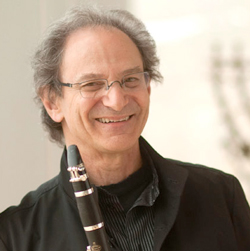by Carlyn Kessler

The group’s performance of the lighthearted work was an amiable opener to the program. Pilgrim’s acoustics are especially kind to the piano, whose sound projects straight into the balcony, often providing an acoustical challenge to mid-range and bass instruments. Cohen and Docter played standing up, helping to balance out the sounds of the three instruments.
The song-like opening Andante set up a sense of warmth and generosity that prevailed throughout the performance of the work. In the conversational last movement, Rondeaux: Allegretto, each musician seized the opportunity to shine, projecting a true Mozartian charm. This was chamber music at its most synergistic.
Next came the premiere of the first movement of Cleveland-born composer David Conte’s Sonata for Clarinet and Piano, written for Franklin Cohen specifically for the occasion. In his program notes, Conte helpfully outlines the structure of the movement, describing the first theme as “a broadly sung lyrical melody, supported by an undulating accompaniment in the piano” and “unabashedly romantic in character.” The singing, Romantic quality of the opening interweaves with a questioning clarinet melody of Stravinsky-esque lyricism, soon becoming active and declamatory — two effects that persist throughout the work.
There are also jazz influences: the clarinet’s long line evokes the sound of a singing, nostalgic saxophone against the piano’s percussive, jiving rhythm. Conte’s piece highlighted Cohen’s musical and technical facility. Here and elsewhere in the program, one could marvel at his extraordinary breath control, producing a seemingly endless, flowing line. Javier Gonzalez played the hauntingly beautiful piano part with sensitivity and fervor.
Franklin Cohen’s transcription of Schubert’s “Arpeggione” Sonata, performed with his friend and colleague, pianist Sergei Babayan, followed intermission. Originally composed for the arpeggione, a six-stringed instrument now virtually extinct, the piece is most commonly performed in its transcriptions for cello and viola, and is notoriously challenging. Cohen’s virtuosity was awe-inspiring, and Schubertian flair shone throughout in his arrangement. The sonata is reminiscent of Schubert’s songs, and its folk-like melodies take on a new charisma when played on the clarinet. Babayan, who performed with the piano lid closed, played with great tenderness and care, and his encouraging, rolling lines shined. Both players switched from vibrant running notes to vocal melodies, exuding masterful showmanship while appearing entirely at ease.
Cohen and Babayan joined cellist Bronwyn Banerdt to cap off the concert with an engaging rendition of Beethoven’s Trio in B-flat, Op. 11, “Gassenhauer” (“street songs”). Here, playing with the lid open, Babayan produced delightful ascending arpeggios with a grin on his face. Banerdt’s expressive vibrato blended flawlessly with Cohen’s pure tone to create an immeasurably warm body of sound. Banerdt shined in her heartfelt and warm cello solo at the beginning of the second movement, reminiscent of the composer’s expressive cello sonatas, and Cohen entered with a solo of mirroring tenderness.
The third-movement theme and variations requires true ensemble playing and virtuosic, concerto-like solos from each instrument. The group had no problem projecting in this space, which can be a challenge for any piano trio. They accomplished all that is delightful in Beethoven: shocking contrasts in mood and dynamics, tongue-in-cheek humor, lush and sweet melodies alongside explosions of vibrant color and sound, and crisp, buoyant articulation. Babayan charmingly reminded the listeners not to take things too seriously with a dramatic pause before the last sections, which induced chuckles. The audience was clearly entranced by the work, and the performers received an immediate standing ovation.
Published on ClevelandClassical.com November 9, 2015.
Click here for a printable copy of this article



